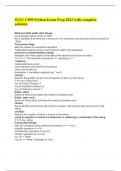Exam (elaborations)
WGU C859 Python Exam Prep 2023 with complete solution
- Course
- Institution
WGU C859 Python Exam Prep 2023 with complete solution Minimum field width with strings print('Student name (%5s)' % 'Bob' the 5 specifies that there are a minimum of 5 characters and thus the print out would be ( Bob) Conversion flags alter the output of conversion specifiers %08d adds le...
[Show more]



